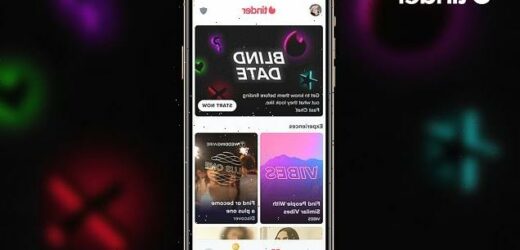Tinder launches BLIND DATES! Users can now enter timed chats with potential matches BEFORE seeing their photos
- Tinder has launched a new feature called ‘Fast Chat: Blind Date’
- Users will fill in icebreaker questions, before being placed in a chat with a match
- Full profiles are revealed only if both members decide to match after chatting
- Tinder said the experience taps into Gen Z’s ’90s nostalgia’ and a desire to experience pre-smartphone dating
It’s the go-to app for millions of singletons around the world looking for love.
And now Tinder has taken inspiration from Blind Date with the launch of its latest feature, ‘Fast Chat: Blind Date’.
The tool allows users to enter timed chats with potential matches before seeing their profile or photos.
Tinder hopes the feature will encourage users to focus more on personality than looks when searching for a match.
Kyle Miller, Tinder vice president of product innovation, said: ‘There’s something really special about letting conversation introduce someone’s personality, without the preconceptions that can be made from photos.’
Tinder has taken inspiration from Blind Date with the launch of its latest feature, ‘Fast Chat: Blind Date’
Blind Dates: How does it work?
Users can answer a series of questions and allow Tinder to pair them based on similar responses before they enter a timed chat based around multiple-choice prompts.
For example, prompts will include ‘It’s OK to wear a shirt ____ times without washing it’ and ‘I put ketchup on ____’.
Full profiles are revealed only if both members decide to match after chatting.
The dating app said its ‘Fast Chat: Blind Date’ feature is directed at its Gen Z users – those aged between 18 and 25, who make up more than 50 per cent of its members – who want a ‘personality first’ approach to finding a partner and are seeking ‘authentic connections’.
Users can answer a short series of icebreaker questions and allow Tinder to pair them based on similar responses before they enter a timed chat based around multiple-choice prompts.
For example, prompts will include ‘It’s OK to wear a shirt ____ times without washing it’ and ‘I put ketchup on ____’.
Full profiles are revealed only if both members decide to match after chatting.
Tinder said the experience taps into Gen Z’s ’90s nostalgia’ and a desire to experience pre-smartphone dating.
In early testing, members who used the Blind Date feature made 40 per cent more matches than those using another Fast Chat feature with visible profiles.
A survey for Tinder found that 47 per cent of Gen Z-aged British adults think that going on a blind date could let them meet someone they might typically have overlooked, and 30 per cent like the idea of a blind date because they value ‘authenticity above all else’.
Mr Miller said: ‘We’ve all seen the mix of anticipation and excitement going on a blind date brought some of our favourite movie or TV characters, and we wanted to recreate that experience for today’s generation with the Blind Date feature.
‘The new Blind Date experience brings a surprisingly fun, banter-based way to interact and create connections that’s all new to Tinder.’
Blind Date is now available in the US and will be rolling out to Tinder members globally soon.
HOW DID ONLINE DATING BECOME SO POPULAR?
The first ever incarnation of a dating app can be traced back to 1995 when Match.com was first launched.
The website allowed single people to upload a profile, a picture and chat to people online.
The app was intended to allow people looking for long-term relationships to meet.
eHarmony was developed in 2000 and two years later Ashley Madison, a site dedicated to infidelity and cheating, was first launched.
A plethora of other dating sites with a unique target demographic were set up in the next 10-15 years including: OKCupid (2004), Plenty of Fish (2006), Grindr (2009) and Happn (2013).
In 2012, Tinder was launched and was the first ‘swipe’ based dating platform.
After its initial launch it’s usage snowballed and by March 2014 there were one billion matches a day, worldwide.
In 2014, co-founder of Tinder, Whitney Wolfe Herd launched Bumble, a dating app that empowered women by only allowing females to send the first message.
The popularity of mobile dating apps such as Tinder, Badoo and more recently Bumble is attributable to a growing amount of younger users with a busy schedule.
In the 1990s, there was a stigma attached to online dating as it was considered a last-ditch and desperate attempt to find love.
This belief has dissipated and now around one third of marriages are between couples who met online.
A survey from 2014 found that 84 per cent of dating app users were using online dating services to look for a romantic relationship.
Twenty-four per cent stated that that they used online dating apps explicitly for sexual encounters.
Source: Read Full Article



